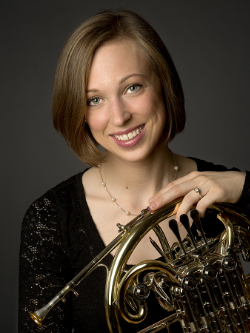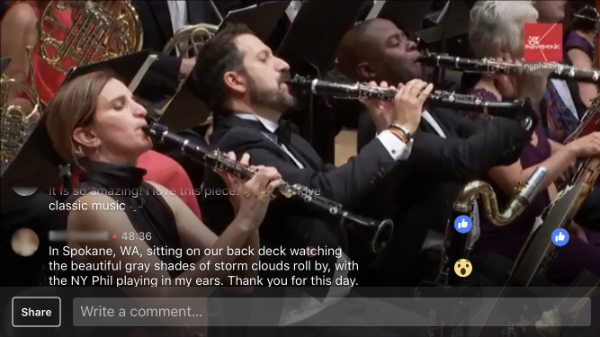
Photo credit: Spencer Lloyd Photography
The New York Philharmonic took an exciting new step last season when we presented three complete concerts on Facebook Live: our 2016-17 Season Opening Gala Concert, a subscription concert of Beethoven’s Fifth Piano Concerto and Brahms’ Third Symphony, and the season finale “Concert for Unity”, featuring guest musicians from around the world. In the Philharmonic’s 175th year, we were proud to be among the very first orchestras to embrace a new media platform.
The New York Philharmonic has frequently performed on PBS’s Live from Lincoln Center for gala concerts, and it’s the sort of thing we look forward to, because it takes an already special evening and elevates it beyond the confines of David Geffen Hall. However, live television broadcasts of classical music are becoming less and less commonplace. We’ve experienced this directly in a reduction of the number of Live from Lincoln Center broadcasts of Philharmonic concerts to just one per season. It was a clever pivot on the part of our digital and marketing teams to look to Facebook Live to fill the void. And as musicians, we felt it was vitally important to maintain a tradition of sharing our performances with an audience beyond New York City (including our own family and friends who we love to have tuning in!).
Of course, there was a small amount of trepidation within the orchestra about doing the live stream, as it was a totally new format for us. Going in, we didn’t know how effective advance marketing would be at drawing people to watch nor what the audio and video quality would be on the Facebook platform. Would the level of performance expected from the Philharmonic be compromised by technical limitations? And of course there’s always added pressure when you’re performing live for a television or online audience that can be many times the size of the crowd in the hall! Ultimately, there was strong support across the orchestra for taking a chance on a new way of reaching people.
For my part, I found the experience of playing live on Facebook to be absolutely exhilarating. I definitely had a few more nervous jitters than I do for a typical subscription concert. The Internet seems to be a notoriously critical environment these days, but overall I found that the people watching online tuned in for the positive, shared experience. This is something all musicians need to keep reminding ourselves—we are naturally inclined to be self-critical and to want to deliver perfection, but I don’t think most audience members listen with these expectations. They’re looking to hear great music and experience a connection with the performers and each other. They are genuinely rooting for the artists onstage (just as I am when I attend concerts, but too often forget when I am the one performing). For some reason, this feeling was more immediate and obvious to me when concerts were being streamed on Facebook Live, versus a traditional television broadcast. Maybe it is because Facebook is a more democratic medium than TV, a platform on which many people are already comfortable sharing their opinions, photos, and real day-to-day lives.
I also loved the idea that someone might casually “stumble across” our concerts while browsing Facebook, and have the opportunity to hear some incredible classical music without any preconceived notions—and without the pressure to stay “tuned in”. If they liked it and kept watching—great! If not, then at the least the visibility of the arts continues to grow, and perhaps a seed or two gets planted somewhere along the way.

NY Philharmonic musicians Amy Zoloto, Pascual Martínez Forteza, and Anthony McGill in a screenshot from the recent Facebook Live stream of a performance of Mahler’s Fifth Symphony
Photo credit: Courtesy of the New York Philharmonic
But by far the best aspect of playing on Facebook Live was the active online community formed around each event. Only in this format could people react in real time to what they were seeing. I was riveted in the hours following the concerts, scrolling through the thousands of comments written during the live stream. People were able to ask questions and have those answered by other viewers, to comment on their favorite parts of the music or when they saw their favorite instrument on the screen, and to have real conversations with other audience members as the performance was happening. Best of all, those orchestra members who weren’t playing a given piece could be backstage also chiming in on the comments from their own devices. It added a level of insider access and, dare I say, “celebrity” to the conversation! Reading through the comments, knowing precisely what moments they responded to and looked for in the performance, I felt closer to the audience than I ever have. I would guess that they felt closer to the performers and the experience of creating music in that space as well.
Finally, I think the Facebook Live concerts were a huge success for the orchestra, and left us feeling very proud of our ensemble, our traditions, and our listeners. I hope such live broadcasts will continue, and we at the Philharmonic can find a way to make these programs part of who we are as a group. In fact, by the time you read this, we’ll have streamed our new season opening concert, hopefully to the sort of response and enthusiasm detailed above. There are of course discussions to be had in presenting more concerts like this—the dichotomy of offering free online access to a ticketed live event, for instance, or how the various media agreements might best be adapted to the world of social media. But all in all, the consensus at the New York Philharmonic was that Facebook Live and other platforms represent the new paradigm in media, and one we would be smart to take advantage of. In many ways, we were glad to be finally catching up with the trend toward live-streamed concerts, already offered by the Detroit Symphony Orchestra, the Berlin Philharmonic, and our neighbors across the plaza at the Metropolitan Opera, among others.
Going forward, a streaming format such as Facebook Live offers numerous opportunities for audiences to get closer to the music than ever before. In the course of our three concerts, the format expanded to include backstage interviews with guest artists and orchestra musicians answering questions from the online audience. It’s easy to imagine the “backstage” element of the live stream becoming more prominent, to give viewers a closer look at who we are as musicians and what our jobs entail. I would be thrilled to see segments that show how we prepare and warm up before concerts, candid social moments that demonstrate the camaraderie and friendship within the orchestra, and other insights that you can’t get just by going to a concert hall. Program notes need no longer be a printed and written affair in an online concert, or limited to a few paragraphs, when a trove of supplemental information is available at the click of a link on your screen. And for those new to classical music, who maybe aren’t quite ready to step into the concert hall with all its unspoken etiquette and sense of ceremony, an online stream brings the experience to them on their own terms. I strongly believe that what classical music as a genre and industry needs to do right now is give people a reason to care about it and the people who make it happen. In speaking with concertgoers—music lovers as well as skeptics—and just about anyone with whom I talk in passing about the arts, I’ve come to believe that the best way to achieve this is by facilitating personal connections and dialogue between performers and audience members. More than ever before in my experience at the New York Philharmonic, our Facebook Live concerts accomplished this. I look forward to seeing how we can continue to harness the potential of social media to grow the circle of those who value live music and feel moved by it. What a fantastic way to bring people into the fold and reward them for being a part of the music!





